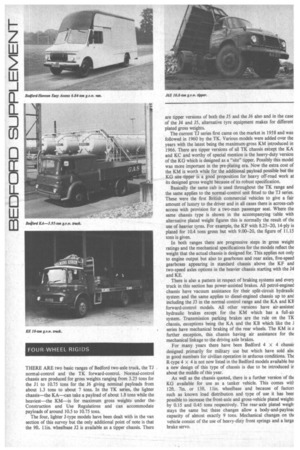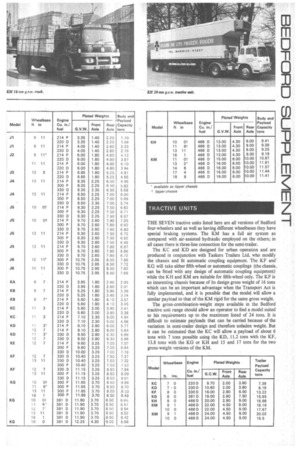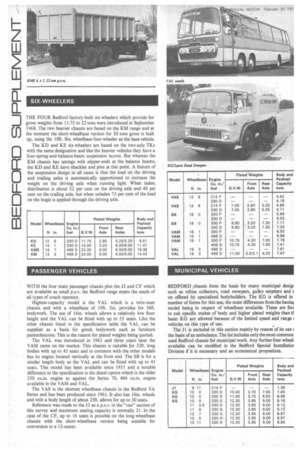[HE VEHICLE RANGE
Page 73

Page 74

Page 75

Page 76

If you've noticed an error in this article please click here to report it so we can fix it.
3edfords from 6owt payload to 24 tons gross by Tony Wilding,
M1MechE, M1RTE
VANS 'HE SMALLEST commercial vehicle made by Vauxhall Motors ,tcl is the Bedford HA van which comes in two forms, one for a cwt. payload, the other to carry 8cwt. Components from the riva car range are used in the HA although changes to body hape were not made when the latest Viva was introduced, the van :taining the original styling of the car.
Internal capacity of the HA van is 61 cu.ft. plus 9 cult. eside the driver if the optional passenger seat is not fitted. Rear oor aperture is 40.5in. and the double doors have a 35.21n. eight. Floor length of the body is 67.2in.
Latest Bedford vehicle to come onto the market is the CF van dlich replaced the popular CA at the end of October last ear. There are five basic models in the range giving nominal ayload capacities of 14, 18 and 22cwt. for the short-wheelbase ersions and 25 and 35cwt. in the longer wheelbase. On the 35cwt. lode] there arc twin rear tyres as against singles on the other four.
Body capacity of the 8ft. 10in. wheelbase CF is 185 cult. and on the 10ft. 6in. wheelbase models it is 252 cu.ft. In both cases there is an additional 16 cult. beside the driver which can be used when the optional passenger seat is not fitted. Respective floor areas for the two wheelbase versions are 41.5 sq.ft. and 50.5 sq.ft., floor lengths being 8ft. 8.8in. and 9ft. 4.8in. respectively.
Taking into account variations such as sliding or hinged cab doors, side loading doors and chassis-cab and chassis-cowl versions, there are in all25 different basic models in the CF range. Each is available with a petrol or diesel engine, the petrol unit being the overhead camshaft engine used in Vauxhall cars, the diesel option being either the Perkins 4.108 or 4.154.
The Bedford 7 chassis included in this section are versions of the normal-control trucks described later on and are normally produced by Bedford as chassis-cowl versions for the fitting of van bodywork. There are variations between,the J Models intended for vans as compared to the trucks although in all cases plated axle weights are common.
The ..T1 chassis-cowl gives a nominal payload of 25 /35cwt. and is popular as a small tipper and dropside truck, but many are used for ambulance bodywork retaining the normal control layout. The 72 is similar to the J1 but has twin rear tyres. There is a forward control version used by Duple as the basis for coach bodywork with up to 21 seats but the most well-known example of this chassis is as the basis for the Bedford-Hawson Easy Access van range. For these, the chassis is produced in semi-forward controlform and chassis-cowl examples are available through Bedford dealers for ambulance and other uses. The Bedford 73 and J4 models follow the lines of the 72 and complete the Easy Access range. The Hawson body has a capacity of 430 cult. on the 9ft l lin. wheelbase 72 as compared to 350 cu.ft. on the smaller 71; with 11ft. I lin. wheelbase the 72 Hawson body gives 520 cu.ft. In the case of the 13ft. 5in. wheelbase J3 there is a 700 cult. body, with 760 cu.ft. the figure for the 13ft. 11in. wheelbase J4. Approximately payloads for thethree bigger chassis are 3.3 tons for the 72, 4 tons for the 73 and 5 tons for the J4.
FOUR-WHEEL RIGIDS THERE ARE two basic ranges of Bedford two-axle truck, the TJ normal-control and the TK forward-control. Normal-control chassis are produced for gross weights ranging from 3.25 tons for the J1 to 10.75 tons for the J6 giving nominal payloads from about 1.3 tons to about 7 tons. In the TK series, the lighter chassis—the KA—can take a payload of about 1.8 tons while the heaviest—the KM—is for maximum gross weights under the Construction and Use Regulations and can accommodate payloads of around 10.5 to 10.75 tons.
The four, lighter J-type models have been dealt with in the van section of this survey but the only additional point of note is that the 9ft. 1 lin. wheelbase J2 is available as a tipper chassis. There are tipper versions of both the J5 and the J6 also and in the case of the .14 and J5, alternative tyre equipment makes for different plated gross weights.
The current TJ series first came on the market in 1958 and was followed in 1960 by the TK. Various models were added over the years with the latest being the maximum-gross KM introduced in 1966. There are tipper versions of all TK chassis except the KA and KC and worthy of special mention is the heavy-duty version of the KG which is designed as a "site" tipper. Possibly this model was more important in the pre-plating era. Now the extra cost of the KM is worth while for the additional payload possible but the KG site tipper is a good proposition for heavy off-road work at its designed gross weight because of its robust specification.
Basically the same cab is used throughout the TK range and the same applies to the normal-control unit fitted to the TJ series.
These were the first British commercial vehicles to give a fair amount of luxury to the driver and in all cases there is across-cab access with provision for a two-man passenger seat. Where the same chassis type is shown in the accompanying table with alternative plated weight figures this is normally the result of the use of heavier tyres. For example, the KF with 825-20, 14-ply is plated for 10.4 tons gross but with 9.00-20, the figure of 11.15 tons is given.
In both ranges there are progressive steps in gross weight ratings and the mechanical specifications for the models reflect the weight that the actual chassis is designed for. This applies not only to engine output but also to gearboxes and rear axles, five-speed gearboxes appearing in standard chassis above the KF and two-speed axles options in the heavier chassis starting with the J4 and KE.
There is also a pattern in respect of braking systems and every truck in this section has power-assisted brakes. All petrol-engined chassis have vacuum assistance for their split-circuit hydraulic system and the same applies to diesel-engined chassis up to and including the J3 in the normal control range and the KA and KB forward-control models. All other versions have air-assisted hydraulic brakes except for the KM which has a full-air system. Transmission parking brakes are the rule on the TK chassis, exceptions being the KA and the KB which like the J series have mechanical braking of the rear wheels. The KM is z further exception, this chassis having air assistance for the mechanical linkage to the driving axle brakes.
For many years there have been Bedford 4 X 4 chassi: designed primarily for military use but which have sold alsc in good numbers tbr civilian operation in arduous conditions. The R-type 4 x 4 is not now listed in the Bedford models available bui a new design of this type of chassis is due to be introduced ir about the middle of this year.
As well as the chassis quoted, there is a further version of thc KG available for use as a tanker vehicle. This comes wit} 12ft. 7in. or 13ft. 1 lin. wheelbase and because of factor: such as known load distribution and type of use it has beer possible to increase the front-axle and gross-vehicle plated weight!
by 0.15 and 0.45 tons respectively. The rear-axle plated weigh' stays the same but these changes allow a body-and-payloac capacity of almost exactly 9 tons. Mechanical changes on thc vehicle consist of the use of heavy-dUty front springs and a large brake servo.
TRACTIVE UNITS
THE SEVEN tractive units listed here are all versions of Bedford four-wheelers and as well as having different wheelbases they have special braking systems. The KM has a full air system as compared with air-assisted hydraulic employed on the others; in all cases there is three-line connection for the semi-trailer.
The KC and KD are designed for urban operation and are produced in conjunction with Taskers Trailers Ltd, who modify the chassis and fit automatic coupling equipment. The KF and KG will take either fifth-wheel or automatic couplings (the chassis.. can be fitted with any design of automatic coupling equipment) while the KH and KM are §uitable for fifth-wheel only. The KF is an interesting chassis because of its design gross weight of 16 tons which can be an important advantage when the Transport Act is fully implemented, and it is possible that the model will allow a similar payload to that of the KM rigid for the same gross weight.
The gross-combination-weight steps available in the Bedford tractive unit range should allow an operator to find a model suited to his requirements up to the maximum listed of 24 tons. It is difficult to estimate payloads that can be carried because of the variation in semi-trailer design and therefore unladen weight. But it can be estimated that the KC will allow a payload of about 6 tons with 7 tons possible using the KD, 11.2 tons with the KF, 13.8 tons with the KG or KH and 15 and 17 tons for the two gross-weight versions of the KM. SIX-WHEELERS THE FOUR Bedford factory-built six-wheelers which provide for gross weights from 11.75 to 22 tons were introduced in September 1968. The two heavier chassis are based on the KM range and at the moment the short-wheelbase version for 20 tons gross is built up, using the 18ft. 8in. wheelbase four-wheeler as the base vehicle.
The KD and KE six-wheelers are based on the two-axle TKs with the same designation and like the heavier vehicles they have a four-spring-and-balance-beam suspension layout. But whereas the KM chassis has springs with slipper-ends at the balance beams, the KD and KE have shackles and pins at this point. A feature of the suspension design in all cases is that the load on the driving and trailing axles is automatically apportioned to increase the weight on the driving axle when running light. When laden, distribution is about 52 per cent on the driving axle and 48 per cent on the trailing axle, but when unladen 73 per cent of the load on the bogie is applied through the driving axle.
PASSENGER VEHICLES WITH the four main passenger chassis plus the J2 and CF which are available as small p.s.v. the Bedford range meets the needs of all types of coach operator.
Highest-capacity model is the VAL which is a twin-steer chassis and with a wheelbase of 19ft. 3in. provides for 36ft. bodywork. The use of 16in. wheels allows a relatively low floor height and the VAL can be fitted with up to 55 seats. Like the other chassis listed in the specification table the VAL can be supplied as a basis for goods bodywork such as furniture pantechnicons. This is the reason for plated weights being quoted.
The VAL was introduced in 1962 and three years later the VAM came on the market. This chassis is suitable for 32ft. long bodies with up to 45 seats and in common with the other models has its engine located vertically at the front end. The SB is for a similar length body as the VAL and can be fitted with up to 41 seats. This model has been available since 1951 and a notable difference in the specification is the diesel option which is the older 330 cu.in. engine as against the Series 70, 466 cu.in, engine available in the VAM and VAL.
The VAS is the shortest wheelbase chassis in the Bedford VA Series and has been produced since 1961. It also has 16in. wheels and with a body length of about 25ft. allows for up to 30 seats.
Reference was made to the J2 as a p.s.v. in the "van" section of this survey and maximum seating capacity is normally 21. In the case of the CF, up to 16 seats is possible on the long-wheelbase chassis with the short-wheelbase version being suitable for conversion to a 12-seater.
BEDFORD ;chassis form the basis for many municipal desigt such as refuse collectors, road sweepers, gufiey emptiers and s on offered by specialized bodybuilders. The KG is offered in number of forms for this use, the main differences from the haulai model being in respect of wheelbase available. These are fixf to suit specific makes of body and higher plated weights than t.I basic KG are allowed because of the limited speed and range vehicles on this type of use.
The JI is included in this section mainly by reason of its use the basis of an ambulance. The list includes only the most common: used Bedford chassis for municipal work. Any further four-wheel, available can be modified in the Bedford Special Installatioi Division if it is necessary and an economical proposition.














































































































































































































